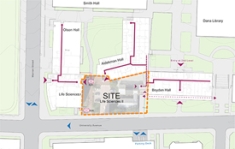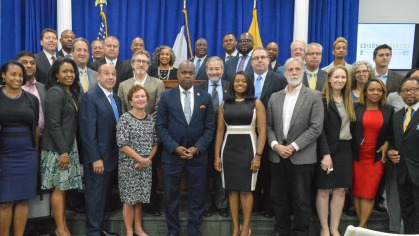State Funding Helps Long-Awaited $59 Million Science Complex Become a Reality
Life Science II Will Modernize Rutgers-Newark, Making It an Attractive Teaching and Research Hub
A $59 million state-of-the-art science facility will soon become a reality for Rutgers-Newark after spending nearly 15 years on the drawing board.
Three chancellorships and one state bond-issue later, plans for the Life Sciences II building have finally emerged, fulfilling a vision that will modernize the Rutgers-Newark campus, making it an attractive teaching and research hub in the sciences.

The concept for Life Sciences II (site plan at left)was first introduced in 2001 when then-Provost Norman Samuels drafted a Master Plan for the Life Sciences at Rutgers-Newark to expand those facilities over the short- and medium-term.
That plan gave rise to Life Sciences I, a 67,000-square-foot gleaming glass-and-limestone building that opened in 2006 and housed cutting-edge chemistry and biology research labs, offices, and chemistry teaching labs and classrooms. The building (at 225 University Ave.) is also home to the cell biology wing of that department, which serves as the driving force behind the cellular biodynamics program.
Life Science I’s north façade was left unadorned, in anticipation of the addition of Life Sciences II next to it. But that project went dormant until mid-2012. The project was resurrected by a state bond-issue referendum, which New Jersey voters approved in November 2012 to the tune of $750 million for construction at the state’s colleges and universities. It was the first time in 24 years that the state borrowed for college construction projects.
In anticipation of the vote, Rutgers-Newark hired an architectural firm to prepare a concept document for Life Sciences II, knowing the campus needed a shovel-ready project in the pipeline to be considered for the bond money.
Once the bond issue passed, the plan was immediately submitted to Rutgers President Robert Barchi’s Capital Planning Committee, which reviewed eligible projects for funding. In February 2013, the Rutgers Board of Governors made its official request to the state for $410 million to fund construction and renovation of academic facilities, listing Life Sciences II among its top three priorities.
Two months later, Gov. Chris Christie submitted a list with more than $1.27 billion in higher-education construction projects to the Legislature for its approval. Rutgers received $357 million, with $67 million in additional monies earmarked for the University of Medicine and Dentistry of New Jersey (UMDNJ), much of which Rutgers was absorbing.
In that package was $59 million for Rutgers-Newark’s long-held dream: Life Sciences II. “It was a watershed moment for our campus,” said Philip Yeagle, the Interim Chancellor who advocated for modernized and expanded science facilities while he was Dean of NCAS from 2007 to 2011. “Rutgers-Newark has had a shortage of high-quality research and teaching labs for too long. We managed to build a new chemistry teaching lab in Olson Hall to help make up for the deficit, but this will move us to a whole new level.”
The new facility will be sandwiched between Life Sciences I, Boyden Hall, and Aidekman Hall, which houses the Center for Molecular and Behavioral Neurosciences. It will connect all three buildings via their respective first floors and become the nucleus of a five-building Life Sciences complex, taking into account Olson Hall, which is already connected to Life Sciences I.
Life Sciences II will contain chemistry and biology research labs, three teaching labs for upper-level chemistry and biology courses, plus a tiered lecture hall that will accommodate new methods for collaborative learning. Part of the space also will be devoted to “entrepreneurial science” research labs for faculty working on technology-transfer research.
This last concept is a cornerstone of the new plan. Language in the bond issue placed a premium on projects that will spur economic development. The thought is that Rutgers-Newark, in collaboration with neighboring research institutions such as NJIT, is well-positioned to develop patentable ideas and incubate start-up companies that can employ campus graduates and train others from the local community. Life Sciences II will enable Rutgers-Newark to be a central part of this initiative by expanding its presence in University Heights Science Park as new faculty are hired and begin working in the facility.
To move the project forward once it was approved and funded, a Life Sciences II Planning Committee was formed, composed of faculty and administrators and led by Chemistry Professor Phil Huskey, who also serves as Director of Science Initiatives for Arts and Sciences.
The committee has honed the original Life Sciences II concept document and chosen an architectural firm to spearhead the building design. The project is scheduled to break ground in August 2014 and be completed for a fall 2016 opening. Artist renderings of the building had yet to be made available as of press time.
Huskey, who has been teaching in outdated Chemistry facilities for years, has high hopes for the new building. “We’ve been in Olson Hall since 1973, in cramped quarters, then moved some of our activities into Life Sciences I. That and the recent renovations to the general Olson lab have helped,” said Huskey. “But Life Sciences II will help us tremendously. We’re looking forward to it coming online.”
FAST FACTS
Life Sciences I
Architects: NK Architects; Area: 67,740 sq. ft
Cost: $20 million; Completed: May 2006
Life Sciences II
Architects: Cannon Design’ Area: 93,000 sq. ft
Cost: $59 million; Completed: August 2016


